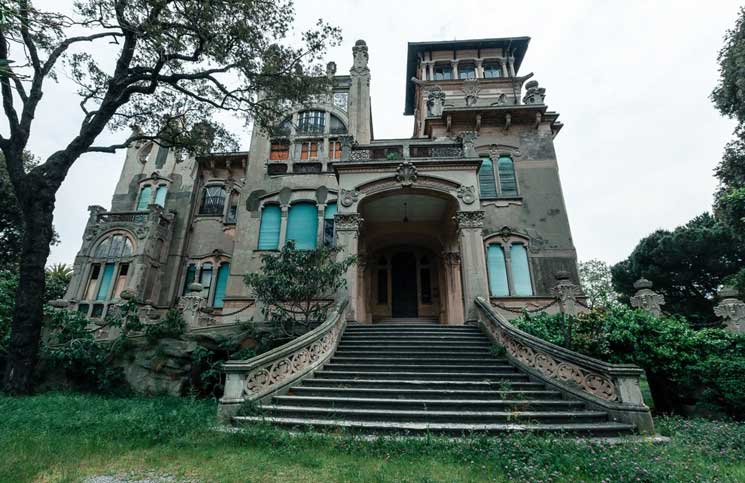1. Villa Zanelli Savona, Italy.

Villa Zanelli, named after the owners, was built in 1907. A few years later, it was handed over to the nearby city of Milan, which used the land as a campsite. During the Second World War, the Red Cross moved in and converted the premises to a hospital, later specialising in heart disease. In the late nineties part of the building collapsed and put an end to these activities, so the place was abandoned.
2. Governor’s Tower, Barcelona, Spain.

The “Governor’s Tower” is a building of eclectic architectural features, thanks to a series of modifications made over the centuries by the owners. Built on the outskirts of Barcelona in the 16th century, it was originally the residence of the Governor General of Catalonia before it was taken over from the 17th to the 19th centuries by the counts of Santa Coloma, viceroys of Catalonia. It was then acquired by the banker Antonio Borrell Folch. He commissioned Guitart i Lostalo, a modernist architect, who added two square towers flanking a Gothic bridge to the entrance. On his death Borrell bequeathed the estate to the order of Friars of the Pious Schools, dedicated to teaching poor children. The buildings were run as a school until the late Seventies. As they became unfit for purpose they were put to other uses. The Borrell Institute closed down permanently in 2000. The property was resold but has since fallen into a state of neglect.
3. Seaview Hospital, New York City, USA.

The former Seaview sanatorium, located in Willowbrook on Staten Island, New York, covers 130 hectares. This vast complex of thirty-seven buildings was constructed between 1905 and 1935 in Colonial Revival style. It was planned on a north/south axis, separating patients according to gender. Although it was originally intended to accommodate tuberculosis cases, the range of patients gradually diversified as children and people with psychiatric conditions were hospitalised there. Seaview, unequipped for modern healthcare practices, was obliged to close down its facilities little by little. Despite designation as a City Landmark in 1985 and inscription on the National Register of Historic Places in 2005, Seaview Hospital is now in very poor shape.
4. Castello di Sammezzano, Reggello, Italy.

Sammezzano castle was built in the early 17th Century in the Tuscan town of Reggello, 19 miles from Florence. Its remarkable Moorish architecture is a succession of domes and arches in an array of colours. In the 19th century, Marquis Ferdinando Panciatichi Ximenes d’Aragona renovated the interior galleries and added to their general eclecticism. On former agricultural land around the buildings, he designed a vast park filled with exotic plants. The castle was auctioned in 1999 to be converted into a luxury hotel complex, but later abandoned and inevitably fell prey to passing looters.
5. Castello di Sammezzano.

6. Bulgarian Communist Party Headquarters, Buzludzha, Bulgaria.

On a rocky peak in the Stara Planina, a range of mountains in the Balkans, the Bulgarian Communist Party Headquarters was built over seven years, between 1974 and 1981, with the help of more than 6,000 workers. It featured a vast auditorium decorated with frescoes of communist leaders and quasi-mythological scenes of heroic battles. But the building was open for scarcely longer than it took to erect, closing in 1989 after the fall of the Soviet Union. It now stands derelict and ravaged by the elements.
7. Bulgarian Communist Party Headquarters.

The auditorium is surrounded by a panoramic circular walkway and topped by a 230ft-high tower. The elevated site ensured that the building could be seen for miles around.
8. Diurno Venezia, Milan, Italy.

These public baths below the streets of Milan were built in an Art Deco style typical of the interwar period. Besides baths, barber shops and sundry recreational facilities, customers had a choice of services ranging from post office and travel agency to shoe-shine boy. A central boiler maintained a comfortable temperature. After the subway was built, the original entrances were used as access points for the new means of underground transport. As the layout of the baths become more confusing, the Milanese gradually lost interest. More and more businesses left the premises. Despite several attempts at restoration, the site is sinking into oblivion.
9. Crespi d’Adda power station, Crespi d’Adda, Italy.

Established to supply electricity to a pioneering “workers’ village”, the power station found itself surplus to requirements when the village’s owners went bankrupt and its inhabitants left in the Twenties.
10. Sanatorium Bourguignon Burgundy, France.

The Sanatorium Bourguignon at Bergesserin, a commune in the Burgundy region of eastern France, took fifteen years to build. Work stopped during the war years 1939–1945, and was completed under contract to a local architect, Monsieur Bidaut. The sanatorium complex consists of two groups of buildings at right angles connected by a vast hall. These are arranged to take account of the natural contours of the land, with between three and six floors depending on the level. From the highest point there is a panoramic view of the adjacent Cluny valley. At the lower levels, the first group of buildings consists of dedicated care units. These are criss-crossed by a succession of galleries leading to bright and practical bedrooms. The second group hosts residents’ other activities and has a canteen, function room and chapel, as well as administrative and technical facilities. Everything is built from reinforced concrete – archetypical functionalist architecture from the post-war reconstruction period. From the 1970s onwards, healthcare had progressed and the sanatorium only accepted convalescents, and then only rarely, until finally all the occupants had gone.
11. Aegidium Cinema, Brussels, Belgium.

Behind the white, very regular and typically neoclassical façade, the Aegidium covers four floors of magnificent interiors in an eclectic style. Built in the early 20th century by the architect Guillaume Segers, this is one of the finest features of Saint-Gilles, a district south of Brussels city centre. Several eras merge as you cross an Art Nouveau entrance hall to reach a Louis XV conference room or a function room decorated in Moorish fashion, which was once converted into a cinema by architect Leon Denis. The Aegidium has been unoccupied since 1985, so needs restoration before it can reopen its doors to the public. The current owner, a community group, has decided to sell and a number of investors are now interested.
12. Battersea Power Station, London, England.

The coal-fired power station in Battersea, south-west London, was built in two stages: the first unit, completed in 1939, was overseen by the renowned architect Giles Gilbert Scott, who gave it an Art Deco interior. The plant took on its existing aspect when the second unit was built in the Fifties. It was finally decommissioned in 1983. Battersea Power Station became famous after Pink Floyd pictured it on their “Animals” album cover. Its characteristic silhouette was also picked up by other artists and filmmakers. The “cathedral of power” and land around it is now the subject of an £8 billion redevelopment which will restore the building to its former glory as well as create 3,500 new homes, offices, shops, restaurants, a theatre, a six-acre park and a £1 billion London Underground link.
13. Stella Brewery, Leuven, Belgium.

Stella Artois beer has been brewed in Leuven since 1366. In 1708, Sebastien Artois, master brewer, bought the “Den Hoorn” tavern and gave this drink a real boost, creating a slightly bitter beer for the Christmas trade. The Stella Artois brand, a blend of the founder’s name and the word “star” (in Latin), was launched in 1926. Production is carried out in Belgium, at the industrial brewery in Leuven. Ever-increasing demand requires modern facilities and space. Sites multiplied in the second half of the 20th century, as breweries were built around the world. Leuven could no longer quench the European continent’s thirst. Production stopped and a new modern brewery took over, right next to its predecessor.
14. Stock Exchange, Antwerp, Belgium.

The Stock Exchange was the first to be built in Antwerp, which had replaced Bruges as a major economic hub. The existing structure dates from the 19th century. Rebuilt over the charred ruins of the 16th century commodity exchange, the rectangular hall is enclosed by four covered galleries, thus altering open and closed spaces. The decline of the exchange coincided with that of Antwerp, as the city’s financial centre lost its standing. In the early 2000s, a property company wanted to convert the exchange into a luxury resort but the financial crisis put an end to that.
15. Salle Sthrau, Maubeuge, France.

Salle Sthrau, in the Maubeuge commune of northern France, was built in the 17th century and was originally the chapel of a Jesuit college. The building was partly destroyed during the First World War, then renovated in 1923 by a Monsieur Lafitte. The exterior walls and pediment were preserved. The interior concrete and ornate wrought-iron and glass ceiling is typical Art Deco. The venue served as a concert hall, a ballroom and for fencing practice, as can be seen in the murals. It was closed in 1998 for safety reasons, but the restructuring work due to be completed by 2015 will allow Maubeuge residents to enjoy this hall again.





